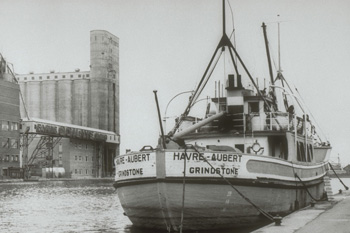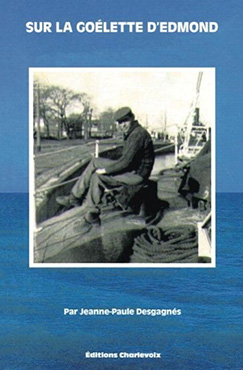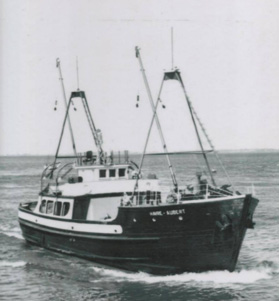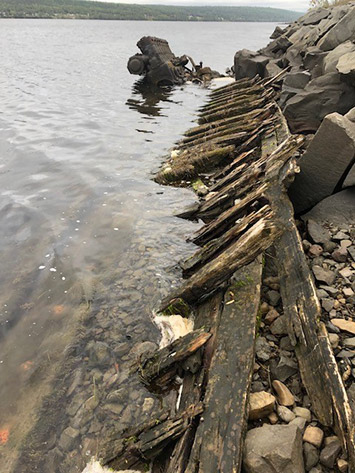The History of the Little Coaster Havre Aubert
Lachine Canal National Historic Site
Thursday, November 19, 2020

Réjean Desgagnés was surprised to recognize his father's ship, the Havre Aubert, in an archival photo of a vessel moored to a wharf in the Old Port of Montréal.
Shared on the Lachine Canal Facebook page last April, the photo jogged his recollection of the ship's history and memories of it that go back 57 years.
The Havre Aubert was 100 feet long and was built of wood in Saint Laurent de l'Île d'Orléans in 1949. Its "sister ship", the Havre aux Maisons, was built at the same time. These two vessels had been ordered by the Coopérative de transport maritime et aérien (CTMA) of the Magdalen Islands.
These ships were coasters, also referred to as St. Lawrence schooners, a name inherited from the days of sailing navigation. They transported various goods between the Montréal and the Magdalen Island ports, such as building materials, food and machinery—everything that trucks carry today. Once their cargo was delivered, it was not uncommon for these ships to bring up a load of pulpwood (commonly referred to as "pitoune" in Quebec) for the paper mills in Québec, Donnacona or Trois Rivières.
These vessels were built to withstand the sometimes difficult conditions for navigating the sea at the Magdalen Islands and in the Gulf of St. Lawrence. Their sturdy hull was reinforced with oak planking and helped them to operate as early as possible in the spring ice.
In 1958, the CTMA sold the Havre Aubert to a Saguenay company. Then my father, Edmond Desgagnés, purchased it in the spring of 1963 and became its captain. He navigated all his life, with his family and sailors from neighbouring towns—from one generation to the next. When he started at the age of 12, navigating the St. Lawrence with this type of vessel mainly involved sailing.

In early summer of 1963, the Havre Aubert crew was trained: my father, Edmond, as captain, my brother Normand as deckhand, my sister Paule as cook and two other employees as first mate and mechanic. And I was the apprentice sailor, which is to say I tried to imitate the others and my attempts often got me in their way more than anything else! Well, you have to start somewhere, right? In June 1963, the Havre Aubert took its cargo of building materials and salt bags from the Port of Québec to supply some harbours down the river. The salt was destined for the Port of Gaspé for fish salting.
As schoolchildren, when June arrived, my sister, my brother and I looked forward to being able to navigate the river with our father during the summer. I still remember the utter joy I felt when, on June 21, I finally boarded the Havre Aubert, with a cloth bag prepared with my mother's help under my arm. After stopping in Baie Comeau to unload a few tonnes of building materials, we set course for Gaspé. I vividly recall the time when, off the Gaspé coast, I asked my father if I could steer the ship into Gaspé Bay. He agreed, with supervision of course, and two hours later we arrived at the commercial wharf at Sandy Beach.

Once the ship was properly moored and the main engine had stopped, the ship's generator, which powered the lights and various equipment, refused to start. Mechanical problems were a common occurrence on vessels so this was nothing overly concerning. An electrician from Gaspé therefore connected the vessel to a shore power source to make sure our equipment was running properly. Little did we know what would happen that night.
At 2 a.m., my father urgently woke me and asked me to hurry out because our boat was on fire! He didn't waste a second and continued to wake up the rest of the crew. I finally went out to the wharf last, behind my father, where the rest of the crew was waiting for us impatiently. My sister said to me that, when I got off the vessel, I told her, "The captain always goes out last!" Apparently I was already very ambitious at that time!
The firefighters worked hard to put out the fire engulfing our beautiful schooner, but they were unable to break through the four inches of the oak deck to put in their hoses. They had no choice but to resign themselves and let the fire sweep through the interior. And our schooner, moored to the wharf, was slowly vanishing in the night.
The fire burned much of the vessel above the waterline. The next day, the brave Havre‑Aubert was still afloat.
Shortly afterwards, a Gaspé diver bought the vessel from the insurance company and used it as a base for diving in Gaspé Bay in the years that followed. The year after the fire, my father bought another 145‑foot steel coaster, the Ste‑Marguerite. He did the same type of transport for a few years.

As for me, I continued to navigate with my father and my family during summers until I was 17 years old. I then worked full time on Canadian Coast Guard icebreakers as a deckhand and a wheelman with the intention of becoming a captain like my father. After three years of travelling in the Arctic, on the St. Lawrence River and in the Gulf of St. Lawrence, I remembered what my mother had always told me. She, the wife of a sailor, had taught us that this occupation was difficult for the lonely wives. And my girlfriend wasn't the only one who was lonely. So I gave up on the idea of becoming a captain, but not navigation and boats.
I studied naval architecture at the Institut maritime du Québec and at the University of Michigan to become a naval architect and marine engineer. I designed a number of types of ships (passenger, fishing, scientific research and recreational) that are operating today. I still design vessels for potential projects for personal and other purposes.
And to continue my apprenticeship as a sailor, I navigate the St. Lawrence River and the Gulf all summer, on my sailboat that I designed.
Even today, if you take York River in Gaspé at low tide, you can still see the bottom of Havre‑Aubert and its engine housing—the remains of a small family ship now loaded with memories.
Réjean Desgagnés, Eng. Naval Architect
Related links
- La Forêt Collective
- École en réseau - To learn connected to others
- A safe and pleasant winter trail
- 5 good reasons to come work for Parks Canada this summer!
- A Colourful Summer at Lachine Canal!
- Reopening of the Lachine Canal - 20 years already!
- Team Up and Clean Up
- Algae and aquatic plants
- 10 reasons to base your business at the Lachine Canal
- New electric vehicle
- Learn-to Paddle
- Newly Renovated Canals
- Public Art at the Hangar 1825
- Planting of trees
- Cyclo-pedestrian roundabout
- Inspirational women
- Date modified :